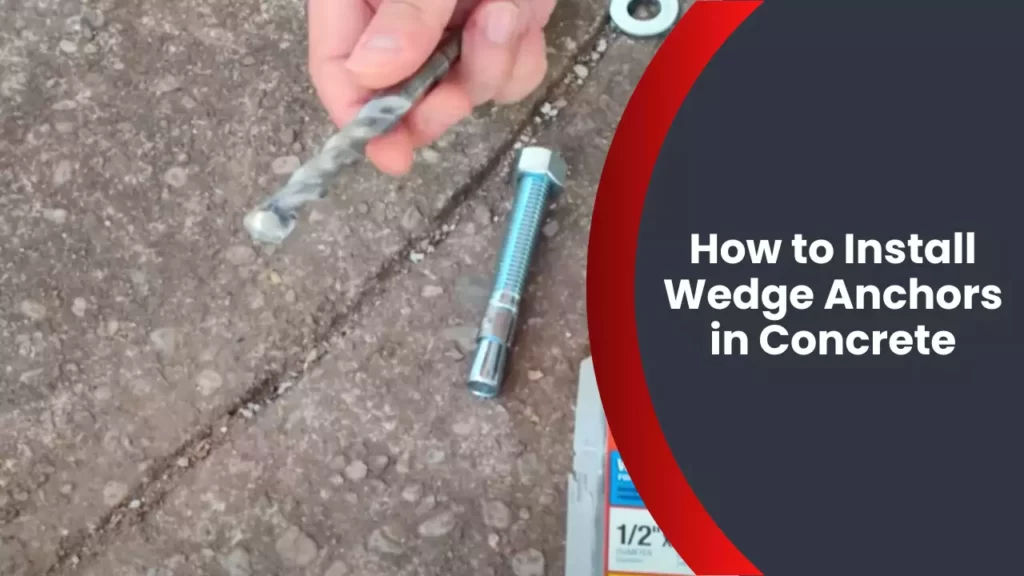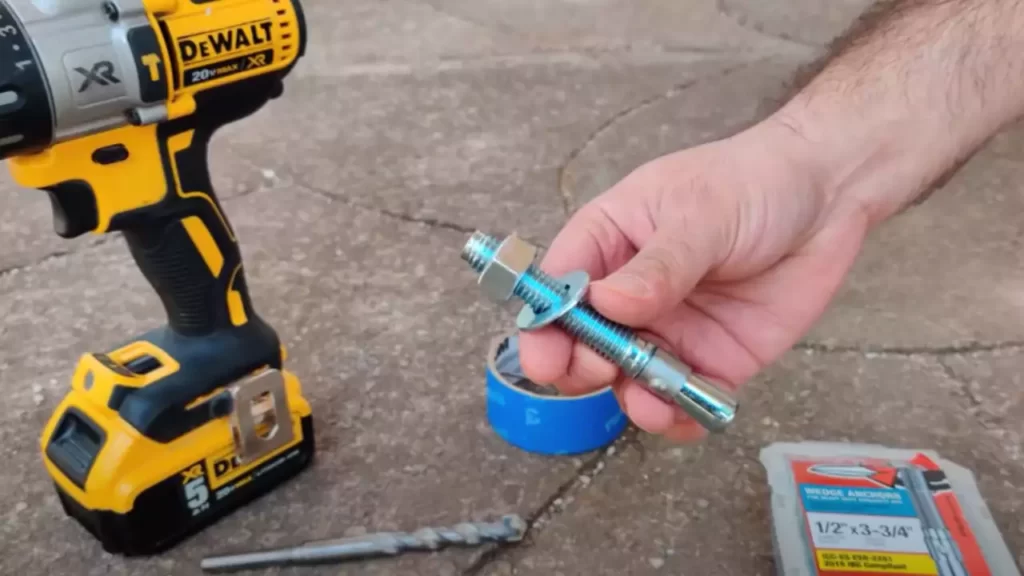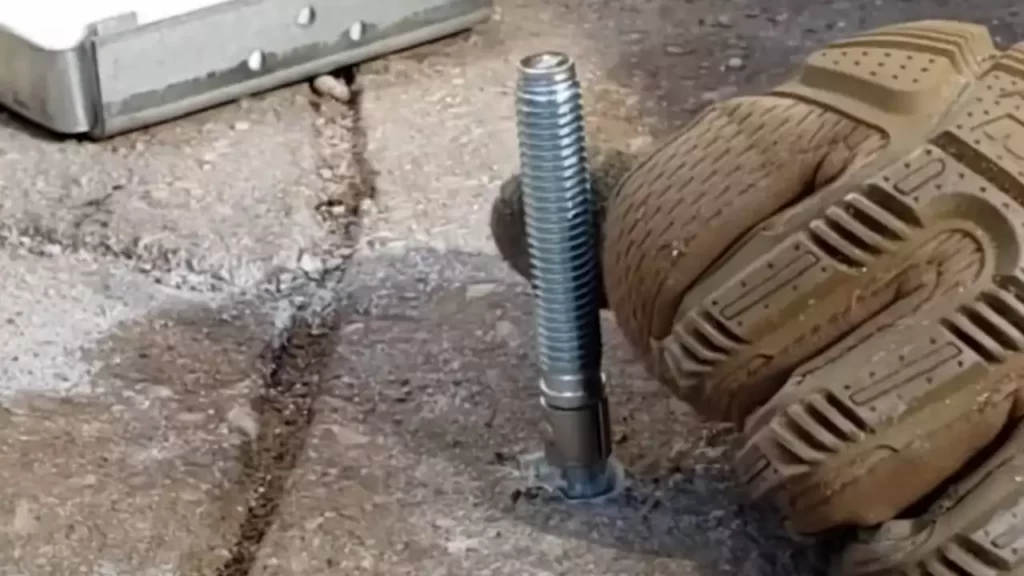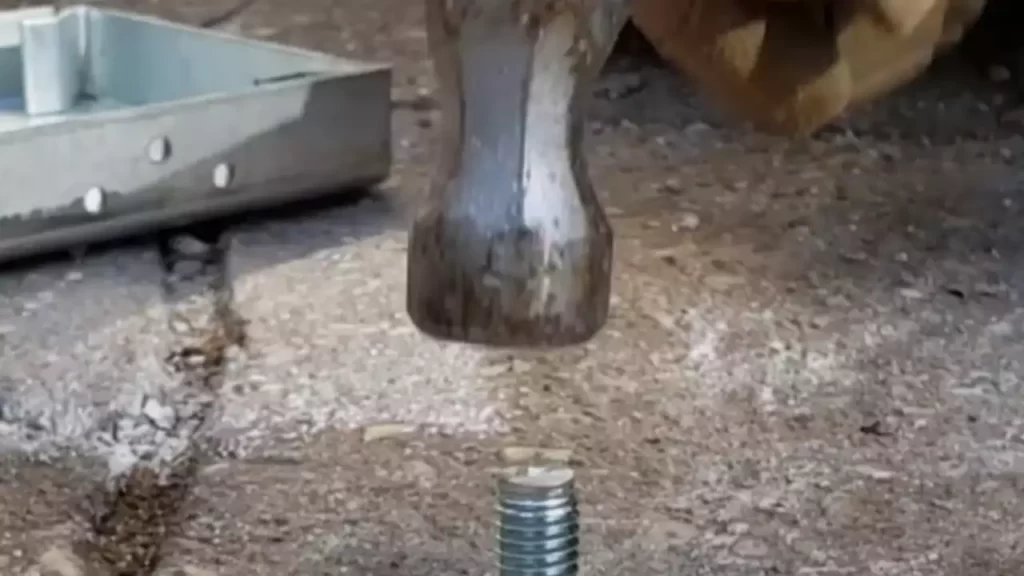To install wedge anchors in concrete, first, drill a hole in the concrete to the specified depth and diameter. Then, insert the anchor into the hole, making sure it rests flush with the surface.
Understanding Wedge Anchors
If you are planning to install heavy-duty objects into concrete, then wedge anchors are the perfect solution for you. These robust and reliable anchors provide exceptional stability, ensuring that your installations are secure and long-lasting. In this article, we will delve into the world of wedge anchors, discussing what they are, the types available, and the advantages of using them.
What are Wedge Anchors?
Wedge anchors are mechanical fasteners specifically designed for anchoring objects into concrete. They consist of a steel thread rod, an expansion clip, a nut, and a washer. When the anchor is inserted into a pre-drilled hole in the concrete, the expansion clip expands and wedges tightly against the concrete. This creates a strong bond that can support heavy loads and withstand various forces.
Types of Wedge Anchors
There are several types of wedge anchors available, each suitable for different applications and load capacities. Here are some common types:
| Type | Characteristics |
|---|---|
| Standard Wedge Anchors | Affordable and suitable for most applications. Can be used with or without an anchor sleeve. |
| Stainless Steel Wedge Anchors | Recommended for outdoor or corrosive environments. Provide excellent resistance to rust and corrosion. |
| Acorn Head Wedge Anchors | Offer added aesthetic appeal with their decorative acorn-shaped head. Ideal for visible installations. |
Advantages of Using Wedge Anchors
Wedge anchors offer numerous advantages that make them a popular choice for concrete installations. Here are some key benefits:
- High Load Capacity: Wedge anchors provide exceptional load-bearing capacity, making them suitable for heavy-duty applications.
- Easy Installation: These anchors are simple to install, even for DIY enthusiasts. With proper drilling and setting, you can achieve a secure and reliable installation.
- Versatility: Wedge anchors can be used in various concrete applications, such as attaching structural components, securing equipment, or installing racking and shelving units.
- Durable and Long-lasting: Constructed from sturdy materials, wedge anchors are engineered to withstand the test of time, ensuring the longevity of your installations.
- Cost-effective: Wedge anchors provide excellent value for money, offering reliable performance at an affordable price point.
Now that you understand the basics of wedge anchors, the different types available, and the advantages they offer, you are well-equipped to make informed decisions when it comes to your concrete installations. Whether you are a professional contractor or a DIY enthusiast, wedge anchors are a reliable choice for achieving secure and durable results.

Preparing For Installation
Before you can install wedge anchors in concrete, it’s important to properly prepare for the installation process. This involves several key steps to ensure a secure and successful installation. By following these steps, you’ll be well on your way to completing your project with confidence.
Choosing the Right Wedge Anchor Size
One of the first steps in preparing for installation is choosing the right wedge anchor size for your specific application. This is crucial to ensure the anchor can safely support the load it will be subjected to. To determine the appropriate size, you need to consider the thickness of the base material as well as the weight it will be supporting.
Understanding Load Capacity
To install wedge anchors effectively, it’s essential to understand the load capacity of the anchors. Each wedge anchor has a specified load capacity, which is the maximum amount of weight it can safely support. Exceeding this capacity can compromise the anchor’s integrity and lead to potential safety hazards. Refer to the manufacturer’s specifications to determine the load capacity of the wedge anchors you are using.
Gathering the Necessary Tools and Materials
Before you begin the installation process, gather all the necessary tools and materials to ensure smooth execution. This will help you save time and prevent any unnecessary interruptions. Here are some of the tools and materials you may need:
- Wedge anchors (according to the desired size and load capacity)
- Hammer drill
- Drill bit (sized according to the wedge anchor diameter)
- Hammer
- Safety glasses
- Dust mask
- Measuring tape
- Pencil or marker
- Dust blower or vacuum cleaner
- Clean cloth or brush
- Wrench or socket set
- Anchor sleeve (if required)
Ensure that you have all these tools and materials readily available before beginning the installation process. This way, you can work efficiently and without unnecessary delays.
Ensuring Proper Safety Measures
When installing wedge anchors in concrete, it’s crucial to prioritize safety. Follow these safety measures to ensure a secure installation process:
- Wear safety glasses and a dust mask to protect your eyes and lungs from flying debris.
- Use proper ear protection if operating a noisy power tool.
- Secure loose clothing and tie back long hair to prevent entanglement.
- Ensure a stable work surface and avoid working at heights without proper fall protection.
- Keep the work area well-lit and free from tripping hazards.
- Familiarize yourself with the manufacturer’s instructions and adhere to them strictly.
Following these safety measures will help prevent accidents and ensure the installation process is carried out smoothly and securely. Remember, safety should always be a top priority.
By preparing thoroughly for the installation process, choosing the right wedge anchor size, understanding load capacity, gathering the necessary tools and materials, and ensuring proper safety measures, you can ensure a successful and reliable installation of wedge anchors in concrete.

Step-By-Step Installation Process
When it comes to installing wedge anchors in concrete, following a step-by-step installation process is crucial for a secure and durable anchor. This article will guide you through the entire installation process, from marking the anchor hole locations to checking the anchor’s securement. Let’s dive in!
Marking the Anchor Hole Locations
The first step in installing wedge anchors is to mark the locations where the holes will be drilled. Use a tape measure and a marker to accurately mark the spots. It’s essential to space the anchors at a proper distance to ensure even weight distribution and structural integrity.
Drilling the Holes
Once the anchor hole locations are marked, it’s time to drill the holes. Use a hammer drill with the appropriate drill bit size recommended by the wedge anchor manufacturer. Make sure the drill bit is suitable for drilling into concrete. Place the drill bit at a 90-degree angle to the surface, apply steady pressure, and start drilling.
While drilling, periodically pull the drill bit out to remove any dust or debris. This will prevent the hole from clogging and ensure a clean and precise hole for the anchor.
Cleaning the Holes
After drilling the holes, it’s important to clean them thoroughly before inserting the wedge anchors. Use a wire brush or compressed air to remove any debris or dust from the holes. This step is crucial as it ensures proper anchor fit and helps in achieving maximum holding strength.
Inserting the Wedge Anchor
With the holes cleaned, it’s time to insert the wedge anchors. Place the anchor into the hole, ensuring it’s flush with the surface of the concrete. Gently tap the anchor using a hammer until it is fully inserted.
Tightening the Anchor
Once the wedge anchors are inserted, use a torque wrench to tighten them. Follow the manufacturer’s instructions for the specific torque value required. Be careful not to over-tighten, as this can damage the anchor or the concrete.
Checking the Anchor’s Securement
After tightening the wedge anchors, it’s vital to check their securement for proper installation. Ensure that the anchors are firmly in place and tightly secured without any visible movement. This step ensures the safe and reliable attachment of your structures to the concrete.
In conclusion, following a step-by-step installation process is key to successfully installing wedge anchors in concrete. By marking the anchor hole locations, drilling the holes, cleaning them, inserting the anchor, tightening it, and checking its securement, you can ensure a secure and durable anchor installation.

Troubleshooting And Tips
When it comes to installing wedge anchors in concrete, it is essential to understand the potential issues that may arise during the installation process. This section will discuss some common installation issues and provide helpful tips to ensure a successful installation. By following these troubleshooting techniques, you can ensure that your wedge anchors are securely installed and capable of handling the required load capacity.
Common Installation Issues
Invariably, some installation issues may occur when working with wedge anchors. Being aware of these problems and knowing how to address them can save you time and frustration. Here are some common installation issues to watch for:
- Insufficient Drill Depth: One common issue is not drilling the hole deep enough to accommodate the anchor fully. This can result in inadequate expansion and reduced load capacity. Always double-check the recommended drill depth based on the anchor size.
- Inadequate Hole Cleaning: Failing to remove debris and dust from the drilled hole can hinder the anchor’s ability to expand and grip the concrete effectively. Ensure that the hole is thoroughly cleaned before inserting the wedge anchor.
- Improper Torque: Each wedge anchor has a specified torque requirement for proper installation. Applying insufficient or excessive torque can lead to anchor failure. Consult the manufacturer’s instructions to determine the appropriate torque value.
- Incorrect Anchor Size: Choosing the incorrect anchor size for your application can compromise the installation’s integrity. Make sure to select the appropriate anchor size based on the load requirements and the thickness of the concrete.
By addressing these common installation issues, you can minimize the potential for anchor failure and ensure a secure and reliable installation.
Tips for Successful Installation
To achieve a successful installation of wedge anchors, consider the following essential tips:
- Use Proper Tools: Ensure that you have all the necessary tools, including a hammer drill, a vacuum or brush for hole cleaning, a torque wrench, and protective gear.
- Follow Manufacturer’s Instructions: Carefully read and follow the manufacturer’s guidelines for installing wedge anchors. This ensures that you are using the correct techniques and torque values for your specific anchor.
- Pre-Drilling and Hole Cleaning: Use accurate drilling techniques to achieve the recommended hole size and depth. After drilling, remove any debris and dust from the hole before inserting the anchor.
- Apply Proper Torque: Use a torque wrench to apply the specified torque accurately. Over-tightening or under-tightening can compromise the anchor’s performance.
- Allow Sufficient Cure Time: Allow enough time for the adhesive used in the anchor to cure properly. Rushing the installation by applying excessive load too quickly can result in anchor failure.
By following these tips, you can ensure a successful installation and maximize the load capacity of your wedge anchors.
Ensuring Proper Load Capacity
To ensure that your wedge anchors provide the required load capacity, it is crucial to consider the following factors:
- Anchor Size: Select the appropriate anchor size based on the specific load requirements. Larger anchors are designed to handle heavier loads, while smaller anchors are suitable for lighter applications.
- Concrete Strength: Consider the strength of the concrete or masonry material in which the anchor is being installed. Weaker concrete may require larger anchors or additional reinforcement.
- Embedment Depth: Ensure that the anchor is inserted with the correct embedment depth specified by the manufacturer. This depth directly impacts the load-bearing capacity of the anchor.
- Edge Distance: Maintain the required distance between the anchor and the edge of the concrete. Not following this guideline can reduce the load capacity and compromise the anchor’s performance.
By taking these factors into account and adhering to the manufacturer’s recommendations, you can ensure that your wedge anchors have the proper load capacity to withstand the intended loads.

Additional Considerations
While understanding the basics of how to install wedge anchors in concrete is important, there are other considerations to take into account for a successful installation. In this section, we will explore how to use wedge anchors in different concrete types, environmental considerations, and maintenance and inspection.
Using Wedge Anchors in Different Concrete Types
Not all concrete is the same, and it’s crucial to select the right wedge anchors for the specific type of concrete you are working with. The two primary types of concrete are standard concrete and lightweight concrete.
Standard Concrete:
Standard concrete is the most commonly used type and offers excellent strength and durability. When installing wedge anchors in standard concrete, make sure to use high-quality anchors that are designed to withstand heavy loads. It is recommended to use zinc-plated or stainless steel wedge anchors for added corrosion resistance.
Lightweight Concrete:
Lightweight concrete, as the name suggests, is lighter in weight and has a lower density compared to standard concrete. When working with lightweight concrete, it’s crucial to choose wedge anchors specifically designed for lightweight applications. These anchors typically have shorter lengths and larger diameters to ensure proper embedment in the less dense material.
Environmental Considerations
Before installing wedge anchors, consider the environmental conditions that may impact their performance. Extreme temperatures, high humidity, and exposure to corrosive substances can all affect the long-term stability of the anchors.
When working in environments with high humidity or exposure to moisture, it is essential to choose wedge anchors with corrosion-resistant coatings such as hot-dip galvanized or epoxy coatings. These coatings provide an added layer of protection against rust and corrosion, ensuring the anchors maintain their strength and reliability over time.
When installing wedge anchors in areas prone to extreme temperatures, select anchors that are specifically designed to withstand these conditions. Heat-treated or cold-weather wedge anchors are often recommended to ensure optimal performance and prevent anchor failure due to thermal expansion or contraction.
Maintenance and Inspection
Maintaining and inspecting wedge anchors regularly is crucial to ensure their continued performance and safety. Here are some key aspects to consider:
- Inspection Frequency: Regularly inspect the wedge anchors following the manufacturer’s recommendations or as required by relevant industry standards.
- Visual Inspection: Check for any signs of corrosion, damage, or movement. If any issues are identified, promptly address them to prevent further deterioration.
- Load Capacity Checking: Periodically assess the load capacity of the anchors, especially if there have been any changes to the load conditions or structure.
- Tightening: Check the tightness of the wedge anchors periodically, ensuring they are securely fastened according to the manufacturer’s specifications.
- Replacement: If any anchors are found to be damaged or not meeting the required performance standards, replace them immediately to maintain the integrity of the installation.
By following these maintenance and inspection practices, you can ensure the long-term reliability and safety of your wedge anchor installations.
Frequently Asked Questions
How Deep Do Wedge Anchors Need To Be In Concrete?
Wedge anchors in concrete should be embedded at least the minimum required depth, usually 5-7 anchor diameters. This ensures sufficient holding power and secure installation.
How Do You Install Concrete Anchors?
To install concrete anchors, follow these steps: 1. Drill a hole in the concrete where you want the anchor to go. 2. Clean out the hole to remove any debris. 3. Insert the anchor into the hole. 4. Tighten the anchor with a wrench or drill until it is secure.
5. Test the anchor to make sure it is holding properly.
What Size Hole Do You Drill For A 1 2 Wedge Anchor?
For a 1/2 wedge anchor, drill a hole with a diameter of 5/8 of an inch.
Do Concrete Wedge Anchors Need Epoxy?
Concrete wedge anchors do not require epoxy. They are designed to secure objects directly into concrete without the need for additional adhesives. These anchors provide a strong and durable hold for various applications.
Conclusion
To sum up, installing wedge anchors in concrete can be a straightforward process if you follow the steps outlined in this blog post. By using the right tools, drilling the correct size of the hole, and ensuring a proper anchor placement, you can confidently secure heavy objects to concrete surfaces.
Remember to always prioritize safety and consult professional advice if needed. With this knowledge, you’ll be equipped to tackle your concrete anchoring projects with ease. Happy anchoring!
